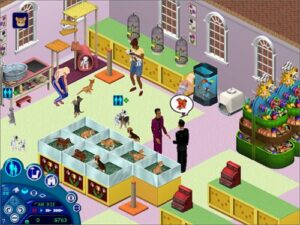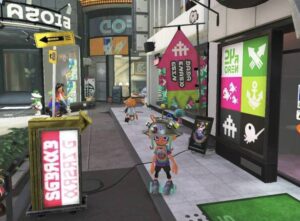Conlangs, or constructed languages, is a category of languages deliberately created by individuals or groups – as opposed to the seven or eight thousand natural languages on this planet. My interest in conlangs is already well-documented here on Lingoblog, but I also have an interest in games: Board games, word games, video games, and the mechanisms which make all of them work.
For the next couple of Wednesdays, I will be discussing a few video games which use conlangs in interesting ways.
I’ve been wanting to write this mini-serial after I noticed a small trend. It seems to me that game developers in recent years have been experimenting with the interactive potential of unique language systems, and this has led to a handful of games utilising conlangs in really exciting ways. More specifically, I’m thinking of a trio of Indie games (i.e. games developed by small studios, often characterised by a greater creative freedom) built around the potential of conlanging.
But I won’t actually be writing about those games until next week. Instead, I’d like to use this first blog entry to set the scene by describing how some of the big companies have used conlanging in the past.
The first of these is a classic which I’m confident that a good portion of Lingoblog’s readers will have had at least some kind of experience with. The Sims is developed by the game studio Maxis and published by EA Games, and although it exists on many different game consoles, it’s the PC and Mac versions which are generally thought of as ‘the proper ones’. The series spans many games, including so many spin-offs and expansion packs that you’d fall asleep before you managed to count them. But the original game is from 2000, and it posed a challenge to what a conventional mainstream video game should be, seeing as there’s no way to win or lose the game. Instead, the player creates a house, a neighborhood, a family, an entire population, and then simply lets them live their lives with varying levels of interference from the player.

The Sims wasn’t by any stretch the first game to play with established conventions, but I find it fascinating how a game with no high score or clear goal could become quite as big as The Sims has. And it’s not that I don’t get the appeal – I’m no stranger to the experience of spending twenty minutes building an in-game house, only to look up and realise that somehow, several hours have passed.
Those of you who are familiar with the game already know where I’m going with this. One of the game’s most iconic elements is Simlish: The language spoken by the game’s characters. When the developers first made this game, it was a priority for them to give the player a feeling of creating something real. But at the time, a game disc didn’t provide the space to store enough voice clips for the characters to sound convincing. The dialogue would have to be repetitive to the point of uncanniness. And if the language isn’t believable, neither are the people using it – which should give you a sense of just how central language is to our sense of reality.
So instead, the developers decided to aim for a linguistic expression that would be deliberately indecipherable to the player. They experimented with English-speaking voice actors reading lines in Ukrainian, Navajo, Tagalog and Estonian, among other languages, but the lines were still too recognisable as real languages. In the end, it was one of the voice actors, Stephen Kearin, who came up with a solution. Inspired by an exercise from his background in improv theater, he delivered a sequence of ‘nonsense’ sounds with no set meaning, but with exaggerated intonation which communicated particular feelings to the listener – like hearing fluent speech in an unfamiliar language. This became the basic principle of Simlish, and the language has been ubiquitous in the series since then.
But can Simlish really be called a conlang? In my opinion, only in the broadest sense of the word. There’s no planned syntax, morphology or phonology, and only an extremely limited set of words with established meanings. There has been attempts to write grammars and vocabularies of Simlish, but since no great consideration of linguistic systems went into the language, it’s hard to get a consistent grammar out of it. The most comprehensive analysis of Simlish is done by the linguist Emma J. Merritt on her blog Words Words Words, and it tells us a few interesting things about the language: It uses largely the same sounds as English, which isn’t surprising considering it’s based on gobbledegook produced by English speakers, but it seems to have slightly different phonotactics. For example, Simlish doesn’t allow clusters of more than two consonants in a row, as opposed to the three that are allowed in English. Simlish, however, is slightly more flexible with what sounds it allows in those clusters.

The second game on my mind uses a similar strategy as The Sims, but also builds upon it. The first Splatoon game was released by Nintendo in 2015 and is about a civilisation of mutant squid creatures which have evolved into something somewhat humanoid after climate changes have annihilated humanity. These colourful creatures, called inklings, speak in a pseudo-language built on the same basic principle as Simlish, although the sounds used here draw inspiration from both English and Japanese phonologies. But the interesting thing about the Inkling language is its scripts – plural.
Splatoon builds a wide-ranging culture for its squid people. There’s a plethora of clothes, shoes and hats with which to customise your character, and every single item of clothing bears the mark of one of the many clothing brands that were invented for the game. The game’s developers came up with names and backstories for the individual members of the many bands who – within the fiction of the game – created what we as players experience as the background music, and covers have been designed for each of their (still entirely fictional, mind you) albums. Mechanically, Splatoon is just about shooting colourful ink everywhere, so this attention to detail is not at all necessary in a mechanical sense – it’s all just to strengthen immersion.

In other words, Splatoon is exactly the type of game for which you might hire a conlanger to create one or more full languages purely to strengthen immersion, but as it happens, they didn’t. But they did go farther than The Sims, because Splatoon’s world is full of text, which visually resembles a mix of Latin, Cyrillic and Japanese writing systems.
In fact, these texts are written in not one, but twelve different scripts, which gives the player a feeling that squid society contains some degree of linguistic variation. However, each script is simply a cipher, which is to say that every symbol corresponds directly to a letter in the Latin alphabet, and all the meaningful text in the game is in fact written either in English or in Romanised Japanese. To a conlanger, this may seem like a strange compromise – a lot of effort for an effect that doesn’t completely hold up to scrutiny. But it is in keeping with the game’s overall worldbuilding philosophy, which seems to be to create immersion through quantity.
Ciphers have often been used for worldbuilding purposes, such as in Minecraft and in the Legend of Zelda games (which also feature a variety of scripts, though not to as extreme an extent as Splatoon), but it seems an interesting development that developers are now choosing to design multiple written versions of the same spoken language. After all, that reflects reality: No spoken language is inherently tied to any specific script, and many languages have multiple scripts, including Punjabi, Serbo-Croatian and Japanese.
The original Splatoon game is almost a decade old, and a minor explosion of conlangs has taken place in pop culture since then. I suspect that if the series had begun today, it might very well have featured a couple of full conlangs. In fact, Nintendo has already released a game containing a full conlang: 2021’s Metroid Dread gives us the Chozo language, which exists in both spoken and written versions, and the same is true of Dovahzul, the language of the dragons in the popular fantasy RPG Skyrim from the company Bethesda.
There are without a doubt plenty of other examples, but I’ve decided to mostly stick to the games with which I have at least some personal experience. The general tendency I see, of which both The Sims and Splatoon are examples, is that the big game companies tend to rely on something reminiscent of conlangs, but without much actual grammar once you really dig into them. Maybe Skyrim and Metroid Dread are signs that the gaming giants are opening up to the possibilities of using full conlangs in their games, but even those games mostly use conlangs as a way to add flavour and realism to their game worlds. And that is a great use for conlangs, but I believe that interactive media can use them for more than that, because I’ve seen examples of conlangs being used not just aesthetically, but as central game mechanics, and those are the games which I’d like to discuss during these next few weeks.
In next week’s blog post, I’ll be discussing the first of those three games that really explore some boundaries of the potential of constructed languages: Chants of Sennaar from the French company Rundisc. Spoiler warning: I highly recommend the game, but I will be revealing some of the central linguistic features in it, so if you think you might have an interest in a language-based video games, I suggest trying to play it before you read next week’s post!
Gustav Styrbjørn Johannessen has a Master’s degree in Linguistics from Aarhus University. He barely speaks any languages himself, but he loves learning about them and wants to show everyone how exciting they are (how exciting the languages are, that is, not the people themselves. He hopes they already know that). He currently spends his time proofreadnig and volunteering for next year’s Sprogense festival.








2 thoughts on “Conlangs & computer games, part 1: The gaming giants”